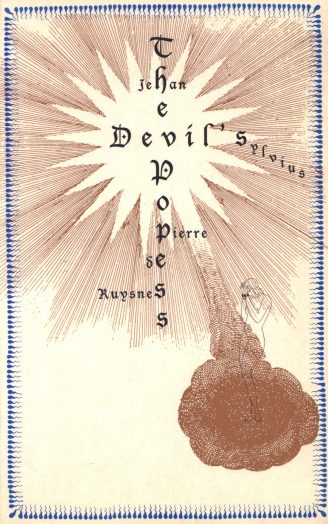By JEHAN SYLVIUS, PIERRE DE RUYSNES (Atlas Press; 1931/99)
This wild and strange novella was initially published in French back in 1931. According to the 1999 introduction by Alastair Brotchie, the accredited authors “Jehan Sylvius” and “Pierre de Ruysnes” are pseudonymous; its actual authors may or may not be the surrealist scribes Robert Desnos and Ernest de Gengenbach. As Brotchie smartly concludes, “Whoever the authors were, they evidently enjoyed themselves.”
Other things I learned from the introduction: that the novel was written primarily for money, that its unknown authors apparently had definite connections with surrealist circles, and that it was originally put out by a publisher specializing in erotica.
Erotic? Not really, although THE DEVIL’S POPESS is fairly racy in spots, and thoroughly outrageous from start to finish. It’s likely the apotheosis of the “yellow peril” potboilers of the time (see Sax Rohmer’s popular Fu Manchu pulps); as the publisher’s blurb description states, “in THE DEVIL’S POPESS these clichés of the period are worked up into a paroxysm taken to the point of parody and/or a parody taken to the point of paroxysm.”
The authors, it must be said, don’t waste any time: in the opening chapter the entire world is decimated by an Asian army under the command of the androgynous Archimagess, the “Mistress of Asia.” The latter is controlled by none other than Satan himself, and on his orders establishes her headquarters in Paris, in a luxurious palace packed with castrated slaves and a lesbian lover named Nadia (Archimagess and Nadia’s chastely described trysts are what gives the tale its sole erotic component).
Archimagess’ outrages include a Satanic banquet in which chained women are ripped apart and their decapitated heads juggled. She also has the pope crucified at the summit of the Eiffel Tower and then seduces his successor. Her reign, it seems, is destined to go unchallenged—until the world is threatened by two colliding stars, leading to mass orgies and cannibalism before an apocalyptic meteor shower puts an end to it all.
Well written this book isn’t. It’s trashy and pulpy in the extreme (I haven’t even gone into Nadia’s torture death or a climactic leper rape), and, needless to add, not nearly as shocking as it must have seemed to readers back in 1931. It is entertaining, however, and hard to beat for subversive fun taken clear over the top.

